Colin Greenwood's intimate portraits of Radiohead capture the band at work and play
Colin Greenwood's portraits of Radiohead have been collected in a new photography book, 'How To Disappear'

History, alas, does not record the debut concert by the artists future-ly known as Radiohead beyond the sketchy memories of their bass player: 'A drunken sixth-form party thrown at a rugby club in west Oxford, with Ed [O’Brien, guitarist] and Thom [Yorke, frontman] and a drum machine. The first gig with my brother [Jonny Greenwood, guitarist] was at the underground Rock Garden, now a gleaming glass-and-brick Apple store in Covent Garden. Jonny didn’t play guitar then, just the keyboards and a penny whistle.'
Luckily, the band (with the addition of drummer Phil Selway) didn’t let their boozy peers put them off, Colin Greenwood became better at documenting the life and times of the greatest British guitar band of the late 20th and early 21st centuries, and his brother ditched the penny whistle.
Now, almost exactly 40 years on from their formation, Colin’s intimate photographs of Radiohead at work, play and yoga are collected in a handsome book, How To Disappear. From rehearsal room to tour bus, Oxfordshire boating lake to Japanese festival, dilapidated mansion jerry-rigged as recording studio to the band’s own Thameside HQ, from sixth album Hail To The Thief to 2016’s ninth and most recent A Moon Shaped Pool, the bass player has (of course) been in the thick of it. His pictures, backstage and up close and off-duty, black and white mostly, but with the occasional burst of colour (his brother’s bright red tour suitcase, disgorging its jumble of blue denim), are as revealing as any Radiohead interview over the years. And I say that from multiple interview experiences with the band.
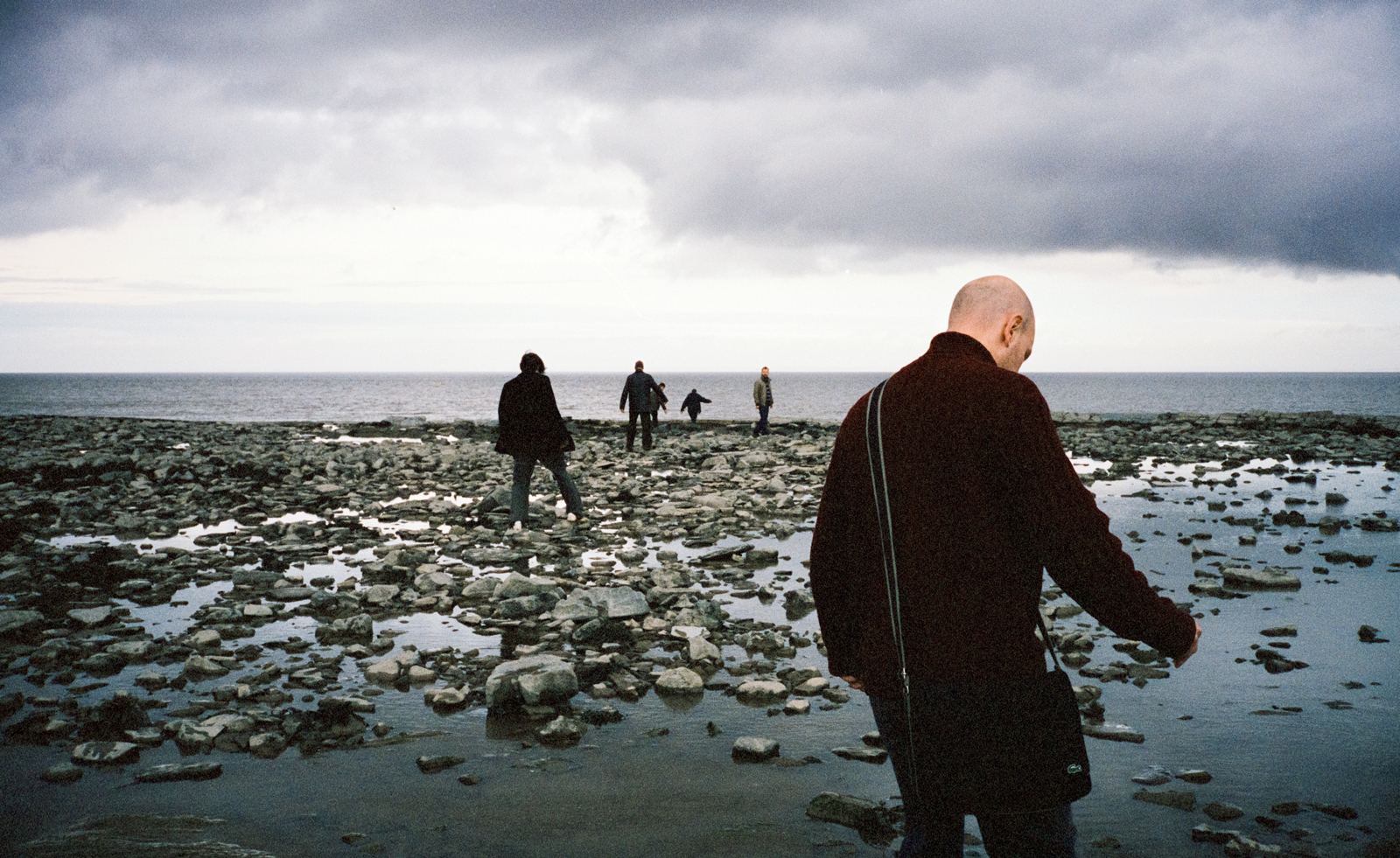
The band on the beach
Still, it’s identifiably a Radiohead project: instead of the band appearing on the cover, there’s a picture, in negative, of some of their concert flight cases. Greenwood grins. 'That photograph was on the cover of the Radiohead website, I don't know, for about three years. Typical obscure obtuseness!' Colin’s photographs begin in 2003. That, coincidentally, is the end-point for the photographs in another recent Radiohead photobook. Climbing Up The Walls is the collected works of Tom Sheehan, the music press photographer who shot the band from their earliest days (full disclosure: I wrote the essays for that book). What, I wonder, changed around that point that inspired Colin to pick up his camera? 'I've only just realised this,' he begins. 'It was us having our own studio, because our studio was done in 2001. So when we did Hail To The Thief, that was the first record that we were working on where our studio was completely finished. That's the reason that caused things to change in terms of the photography. Because there was somewhere that we would go to every day where I could be taking photographs. Before that, there wasn't the same kind of space that felt like somewhere there was time to do that.'
Plus, of course, before that, Radiohead – the band of Pablo Honey, The Bends, OK Computer, Kid A and Amnesia – were running at rocket speed and vertiginous incline. 'Yeah, and I was in the middle of all of that,' nods Greenwood, 55, who has also written for the book a beautiful, 10,000-word essay, full of revelatory memories like that recollection of the proto-Radiohead's earliest gigs. 'I wasn't there on the outside taking the pictures. I was in the middle of it all happening, trying to help it happen. And I just didn't have the mental space to try and think about it in a detached, observer-type way.'
As we speak it’s Sunday morning and Greenwood is Zooming in from Copenhagen. He’s playing with Nick Cave, deputising on their European tour for poorly Bad Seed Martyn Casey. It’s early in the run and many of the touring party have been struck down with flu, but Colin is nonetheless 'having the best time'. 'They're all just such lovely people, and they all talk to each other all the time, and there's lots of laughter. It's a wonderful experience. I can't rate it highly enough. We're playing places that we played probably with Radiohead. I was just reflecting on this this morning: this is something that I've actually been trained to do for a long time!' this famously easygoing groove-machine says with a laugh. 'Even though that I haven't done it for a long time,' he adds, acknowledging Radiohead's lengthy and ongoing hiatus. 'So it's been really, really nice and gratifying to be back doing something that I love.'
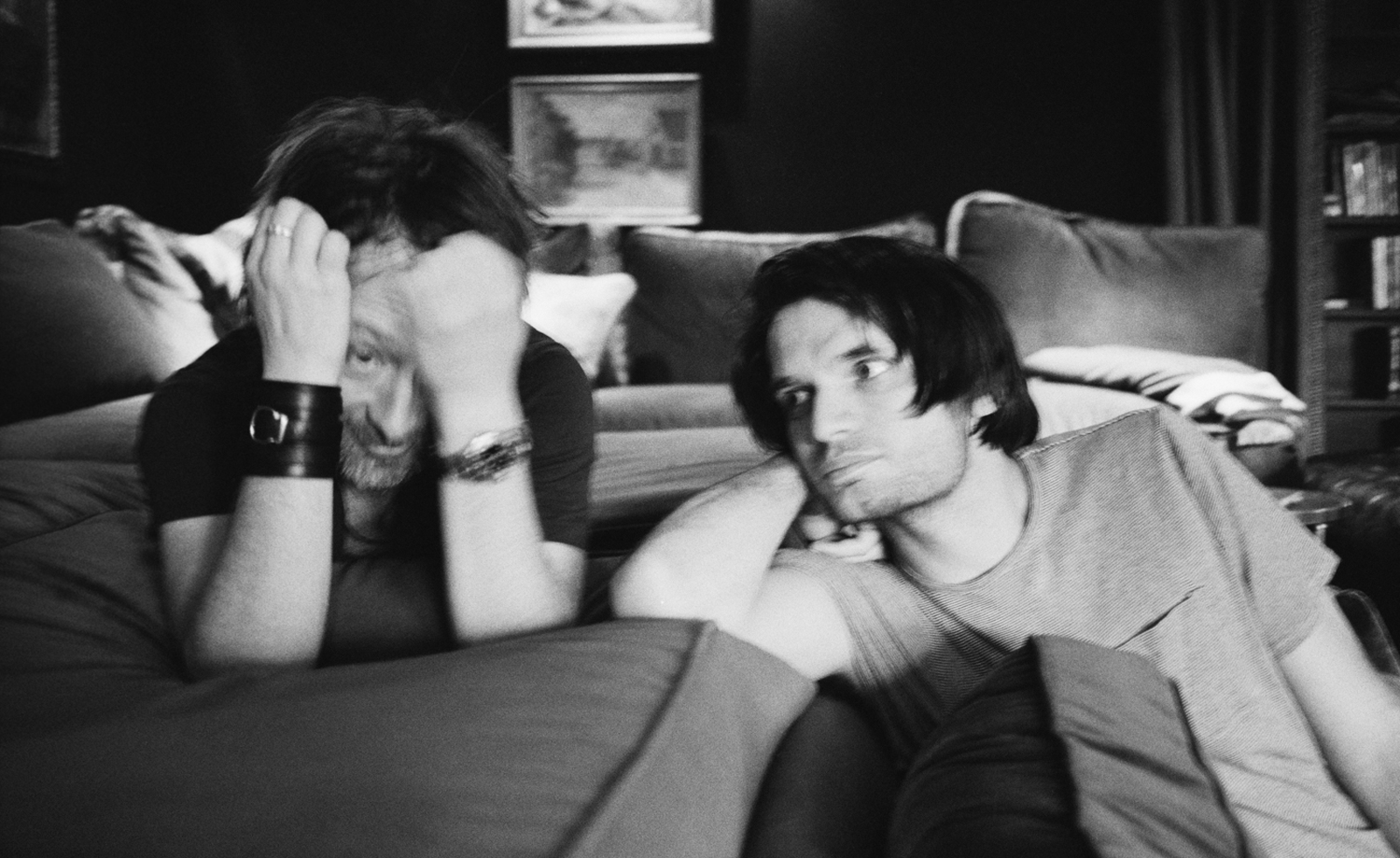
Thom Yorke and Jonny Greenwood
Wallpaper*: You have a huge archive of Radiohead photographs, Colin, and have been thinking about what to do with them for almost three years. How did you decide on the presentation?
Receive our daily digest of inspiration, escapism and design stories from around the world direct to your inbox.
Colin Greenwood: My main concern was, I wanted the book to be a beautiful object. I wanted the photographs to look beautiful. I wanted [quality] paper. I wanted it to be printed in Italy. I wanted it to be hand-stitched. I wanted it to be something that you would hold and you would love. So it's a fine art photography book published by a literary publishing house. I'm really, really proud of it.
Understandably there aren’t many pictures of you. But we do get one beardy portrait early in the book, opposite a picture of a tousled Thom intently playing his guitar.
My brother took that one of me, but with my camera! With a bass that I never played! It's a Fender Mustang. It was originally made for people who are guitarists, who can't handle the sheer length, size and girth of a Fender Precision bass, and have to wussy on down to the short scale Fender Mustang. Those are around 2003 at our studio in Oxford. Thom's outside and I'm inside. I don't know why he's gone outside to play the guitar. He's not busking or anything. Maybe he's practising busking.
Another album, another studio: Thom sitting at a grand piano in scarf and coat. Where is this cold gaff?
That's f*cking freezing Tottenham House, the slightly, scary, crumbling country house in Wiltshire where we did sessions for In Rainbows. We were all sleeping outside in caravans because it was too unsafe to sleep in the actual house. We were on the bit of lawn that they raise up to stop the sheep coming in – the ha ha. So five caravans, and then Dan Rickwood [aka Radiohead sleeve designer and serial collaborator Stanley Donwood] had his festival tent that he takes to Glastonbury every year. Very bizarre.
There are, too, lots of evocative pictures of the band on the tour bus, driving through heartland America.
The theme of the book flows from the cozy confines of Oxfordshire where we're working, out into the world of playing on stages and things. That's the arc of the book. I’m on a tour bus right now, and it's a much more hermetic [vehicle]. We used to have this driver called BJ who drove the Spice Girls and Elton John and David Bowie and had tonnes of unprintable stories. On the front of his bus, you've got the massive windshield and big steering wheel, but he also had these massive speakers. He'd tear down autobahn playing pumping music. It was my favourite bus in the world. So I have to agree with the Spice Girls and Bowie that it was the most incredible rock'n'roll bus in the whole business. That was in the 2000s. Gone are the days where our bus would be breaking down with a paraffin leak and we'd wake up to our driver kicking the paraffin heater somewhere outside Leeds, looking out the windows with little bits of stained net curtain. But those were in the days before photography.
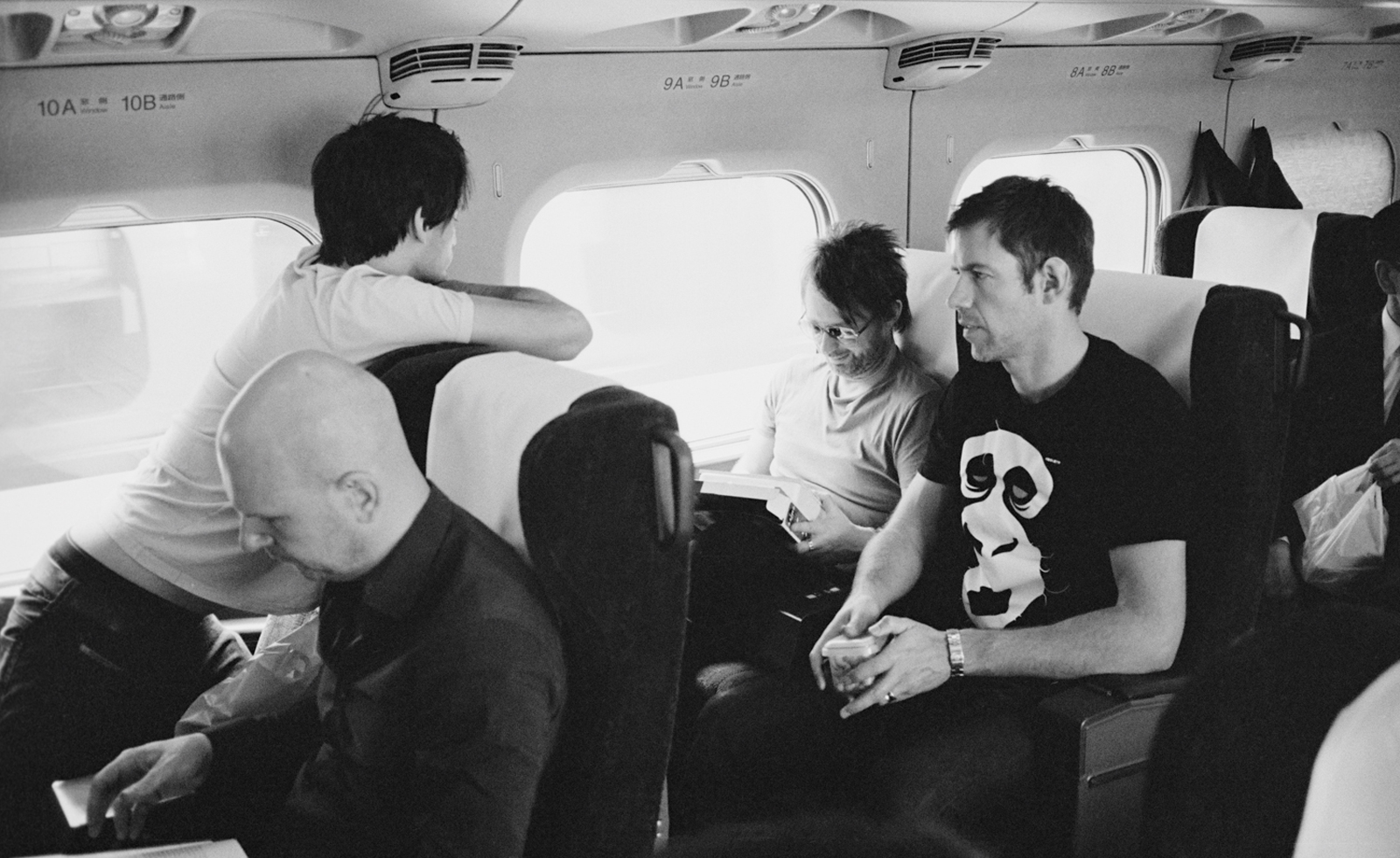
The band in Japan, 2008
Maybe a good thing. Changing mode of transport, you also capture a bowler-hatted Ed as mournful strap-hanger, looking very much like a 1950s commuter.
That's the underground in Japan. Ed's a fish out of water, obviously of who he is and how he looks. That's the image of being uncomfortable in a confined space on the underground, being six foot whatever he is [he's six-foot-five – Ed.]. In the book there's a couple of pictures of Ed looking uncomfortable. In fact, bless him, he's actually probably the shyest person in the group in terms of having his photograph taken.
Even more so than Thom?
I'd say so. There's a photograph in the book of Ed, just after he got up from the bus in 2006 in Blackpool having breakfast. He's giving me real f*ck-off daggers as I'm taking the picture.
I was there that day. I was interviewing Thom because the next morning he was announcing the existence of The Eraser, his debut solo album.
Wow! I took a bunch of photographs then. Then we went to America, and I remember the excitement of seeing those images coming off the contact sheet. That excitement of seeing something that happened, that you were part of, that you photographed and enjoyed – and get to enjoy again by seeing something revealed to you that you didn't see at the time of taking the picture. I love when that happens – whether it's Ed at breakfast or my brother's dirty laundry. When you're in the band and you're doing this thing, it seems very transient. When you take the pictures and you look back at them, it becomes cast in time. Something more permanent happens through seeing the picture. That's really cool.

Jonny Greenwood on the guitar
Like the picture of Thom in a yogi position backstage somewhere?
That's just before going on stage in Tokyo at an outdoor stadium in front of 30,000 people. I hadn't seen him doing that before. And I notice now that his jeans are ripped. I also took lots of pictures of everyone hugging each other, but they're all really blurry and shit.
Are you documenting the Nick Cave tour?
Funny you should ask! I've been taking pics rehearsals, and then some of the touring ones. Lots of pictures of people laughing. Nick would agree with this: [multi-instrumentalist] Warren Ellis is the Jonny Greenwood of the Bad Seeds. Or Jonny Greenwood is the Warren Ellis of Radiohead. In that he's always up for a photograph. And generally looks incredible in photographs.
There were some Radiohead rehearsals in June in London. And next year will be 40 years since the band started. All of the members have individual commitments currently. But do you think the gears are grinding slowly together again for Radiohead?
I think the gears are definitely grinding slowly towards some kind of decision about something! Ha ha! We rehearsed at [producer] Paul Epworth’s studio in London, The Church. In fact, that's where we finished OK Computer. We did a week or something there – I finished the outro for Airbag there. So [last year] we just got together and we rehearsed. We had four days. I think we only did two in the end. Not because we all fell out, but because we were like, well, we've done it, and it's sounding really good. So we can decide what to do with that. My brother said he thought we could just do a couple of weeks and just go and tour. Because it's so ingrained.
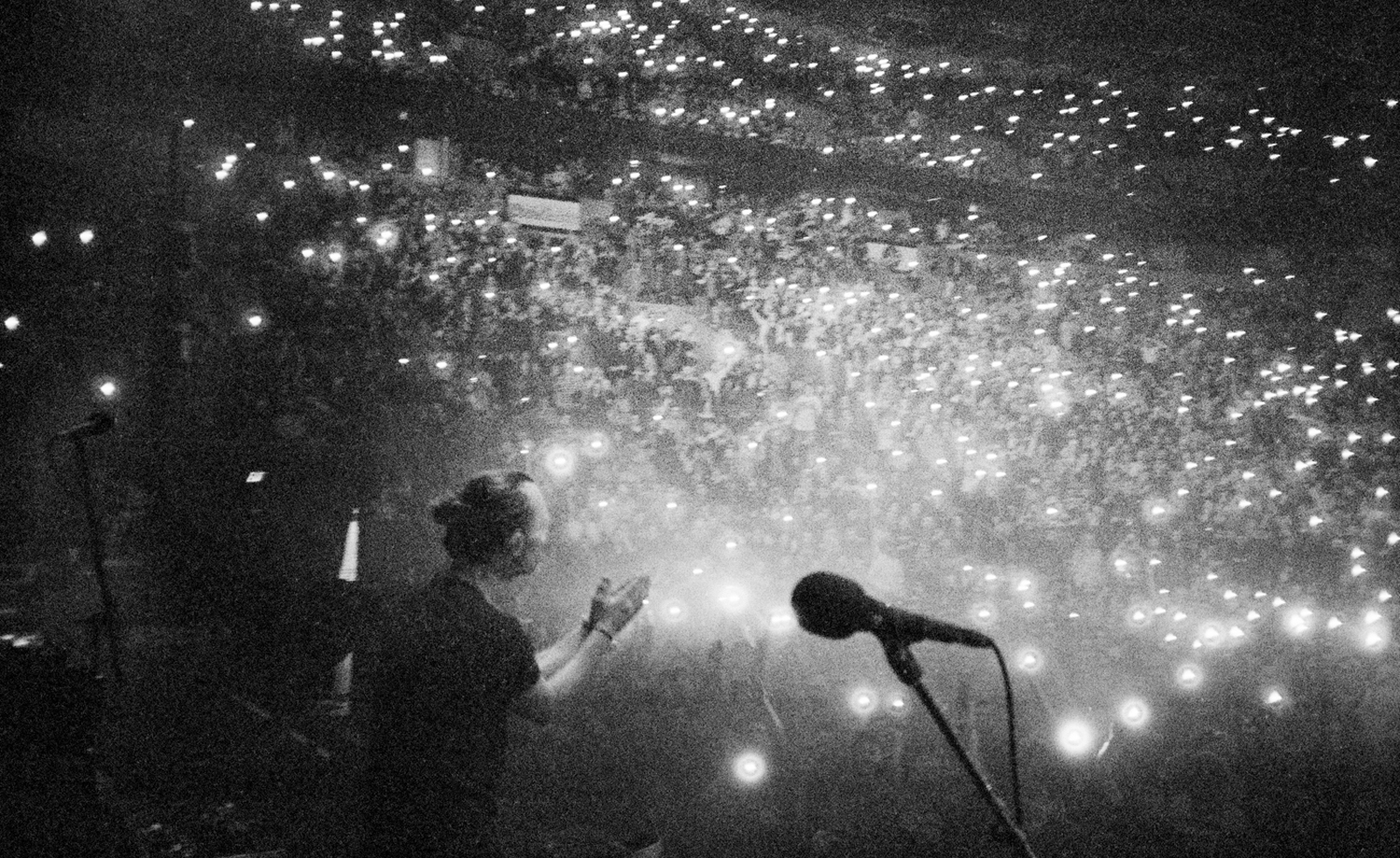
The band in front of an audience
Maybe next year, then?
What, we'll do another two days at The Church! Yeah, maybe we'll do another two days in Crouch End next year. Something to look forward to!
Finally: the title of your book is a truncated version of the Kid A track How To Disappear Completely, the chorus of which goes: “I'm not here, this isn't happening...” Is that emblematic of your desire to be an unobtrusive photographer?
I think so. I did lots of photographs with remote cameras, a bunch of pictures of us playing live. I put up GoPros around the stage, and they look really good, but the angles are a bit weird because I didn’t want them in people's faces. And then I did a bunch of portraits of everybody in the studio. But again, I felt really intrusive. As you know, I'm not very assertive. So this is the best I've got, really.
Well, it's fair to say that the many photographers you’ve worked with over the years would have killed for your access…
We've inflicted a lot of unnecessary grief and trauma on British and American photographers over the past 30-odd years. For which, as a member of Radiohead, I'd like to take this opportunity in your interview to apologise for – and in some small way make amends with my paltry offering!
How To Disappear: A Portrait of Radiohead (John Murray) is out now
London-based Scot, the writer Craig McLean is consultant editor at The Face and contributes to The Daily Telegraph, Esquire, The Observer Magazine and the London Evening Standard, among other titles. He was ghostwriter for Phil Collins' bestselling memoir Not Dead Yet.
-
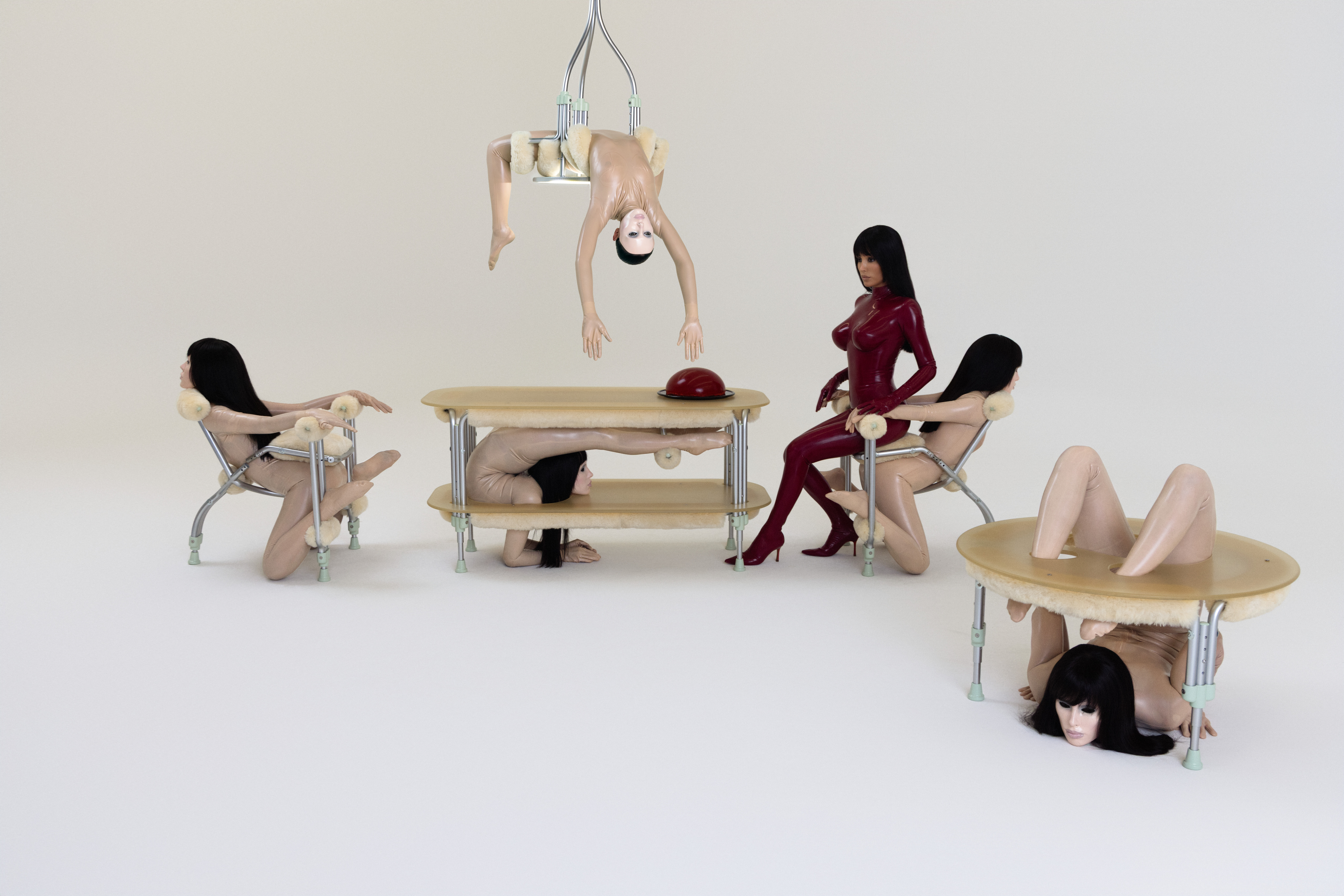 Eight questions for Bianca Censori, as she unveils her debut performance
Eight questions for Bianca Censori, as she unveils her debut performanceBianca Censori has presented her first exhibition and performance, BIO POP, in Seoul, South Korea
-
 How to elevate a rental with minimal interventions? Charu Gandhi has nailed it with her London home
How to elevate a rental with minimal interventions? Charu Gandhi has nailed it with her London homeFocus on key spaces, work with inherited details, and go big on colour and texture, says Gandhi, an interior designer set on beautifying her tired rental
-
 These fashion books, all released in 2025, are the perfect gift for style fans
These fashion books, all released in 2025, are the perfect gift for style fansChosen by the Wallpaper* style editors to inspire, intrigue and delight, these visually enticing tomes for your fashion library span from lush surveys on Loewe and Louis Vuitton to the rebellious style of Rick Owens and Jean Paul Gaultier